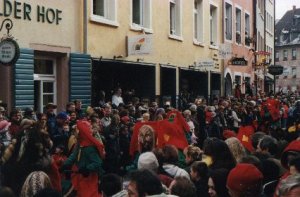| F
r e i b u r g e r F a s n e t - Carnival |
 |
I
never bothered to take any interest in Fastnacht (German
Carnival)…until this year. I went to the Carnival
procession, because I suddenly felt the need to get closer
to this traditional movement.
|
|
Freiburg
itself has 35 Groups or "Zuenfte" of jolly
jesters, witches and devils, so what is it all about? The
going story is the one about the expulsion of the winter
demons and ghosts. This has been derived from pagan winter
rituals prior to the arrival of Christendom in Germany.
|
 |
 |
However,
an article in the online Narren-
Spiegel
(German) magazine, suggests other origins of German
carnival. Back in the 13th century, when life in
Germany (and the rest of Europe) was highly influenced by
the Catholic Church, the time before Easter, when Catholics
celebrate Christ’s resurrection, was a strict fasting
period.
|
|
Due
to that, people had lavish parties before the fasting
started, because there were a lot of food resources, which
needed to be consumed beforehand, since they did not have
preservatives then to keep all foods lasting over months or
years.
|
 |
 |
Toward
the 15th century the festivities took on a
regular place with typical disguising and masking games of
the Middle Ages with its freak processions. These partially
represented the underworld, the opposite to Gods kingdom the
place of the fallen Angels.
|
|
Earthly
life stood for this world according to Christian believes.
And "Fasnet" became the resemblance of the seven
deadly sins. The general course of Fasnet was the start of
the festivities on a Thursday followed by the burning of the
Fasnet spirit on the following Wednesday.
|
 |
 |
The
Thursday was chosen, because it did not interfere with any
religious or other culturally important days in the week.
The burning of the unclean was something that was demanded
by the Catholic Church. It made Fasnet an acceptable and
justifiable fete.
|
|
The
church realised that, by prohibiting the celebrations, they
would loose people’s support, so they achieved a
compromise. Since the Protestants rejected Fastnacht, as
they did not practiced fasting, the celebrations only
occurred in southern catholic Germany.
|
 |
 |
This
is why the south has the most popular processions. However,
during the past decades the North has tried to come up with
its own style. Fasnet was a celebration of the masses, the
simple folk.
|
|
In
those days the simple folk did not have the means to put
together lavish costumes and masks. Initially the
processions were mainly manned with fools and jesters,
people who were beyond social acceptance.
|
 |
 |
This
is why the south has the most popular processions. However,
during the past decades the North has tried to come up with
its own style. Fasnet was a celebration of the masses, the
simple folk.
|
|
In
those days the simple folk did not have the means to put
together lavish costumes and masks. Initially the
processions were mainly manned with fools and jesters,
people who were beyond social acceptance. |
 |
 |
-
Devil,
wild man, wild woman (witch) and animal masks
-
"Zottelgwaender"
costumes (suit with sawn on pieces of left over
materials)
|
-
"Weissnaar",
the beautiful aristocrat type costume with heavy bell
belts (represents vanity and self-absorption)
-
"Schreckmasken",
masks with rough and scary looking faces
|
 |
 |
Unfortunately,
I was not quick enough to take down the names of the
respective Groups. So, if there is anyone who knows the name
of these "Zuenfte" on this Page, please email me
so I can complete the documentation. Anyway i will try and
contact the local "Verein" (organisation) to get
more details.
|
|
Last
edited 19-06-01
All photos by
A. Goss & S. Goss
© A.Goss,
April 2001 |














